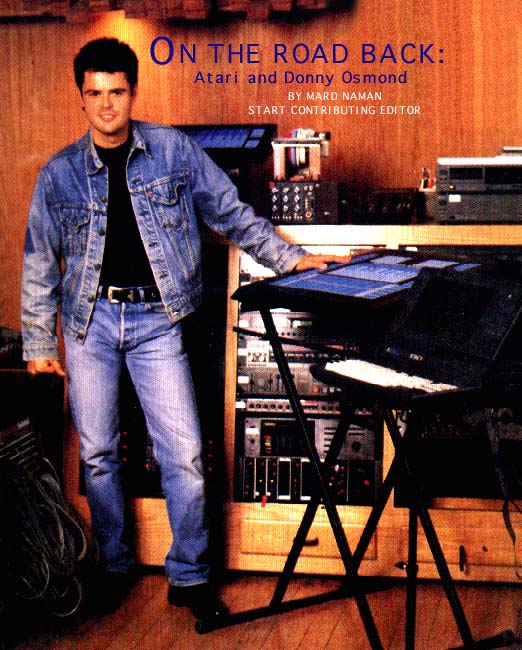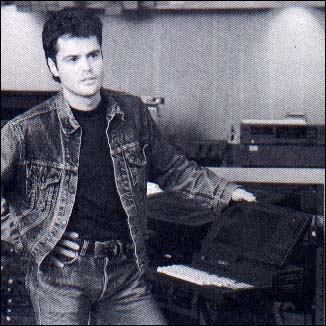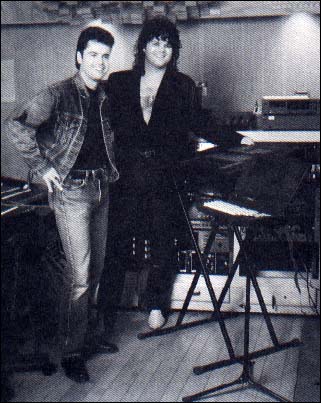
Donny Osmond and Atari have a lot in common. Both have suffered from image problems and both have had extreme peaks of success and valleys of failure. But now both are on their way back--and in a big way. START sent Mard Naman to interview Osmond at the Complex in Los Angeles, where Donny met STACY: It was love at first sight.
It's the first day of summer and singer Donny Osmond is feeling on top of the world. And well he should, because for the first time in longer than anyone can remember, he's on top of the charts. His song "Soldier of Love" has hit #1 in sales and #4 in airplay across the country. His new sound has drawn comparisons to Prince, Michael Jackson and George Michael. Not bad for a guy who was given up for musically dead 10 years ago.
Donny Osmond knows what it's like to fall from the pinnacle of success. And he knows how hard it is to climb back. As a child star, he had one smash single after another and a hit variety show with his sister Marie. But after theDonny and Marie Show went off the air in 1979, it was one long drought. No one would take him seriously as an artist. Songs like "Puppy Love" and "Go Away Little Girl" had branded him as hopelessly unhip, nauseatingly cute and a complete wimp. It didn't matter that the image didn't fit the man. The real Donny Osmond is thoughtful, charming and an unpretentious regular guy. But in a savage backlash to success, the artist who had 26 top-40 singles by 1979 couldn't get another record released in the United States for an entire decade.
Now all that's history. After enduring 10 years of Donny-bashing, Osmond is back with "Soldier of Love" and a hit album, "Donny Osmond," which he hopes will render at least three top-10 hits. Donny Osmond is being taken seriously. Finally.
No longer a boy but still boyishly handsome, the 31-year-old Osmond settles into a chair at the Complex recording studio in Los Angeles. He is here to talk about how far image can be from reality, to talk about his great enthusiasm for the Atari ST and to see the incredible STACY laptop for the first time.
Like a trusted friend, the ST has been with Donny on his comeback trail. Donny used the ST on his new album, and he's using it today for both songwriting and recording. He picked the ST because of its great musical capabilities. But he feels a great affinity with Atari for another reason: both he and the computer have survived false public images to be redeemed in the end.
Parallel Images
Perhaps the most telling statement on Osmond's new album isn't in the music at all, but in the liner notes. "Perception vs. reality is deceiving!" writes Osmond. It's a statement he feels is as true for Atari as it is for him.
Osmond sees great parallels between his life and Atari's. "I'm just like Atari," he says. "I know what it's like to get over an image. If anybody knows what it's like, I do. It's the same with Atari. Nobody took them seriously. But the perception of Atari has been completely different from the reality of it. They're far ahead of everyone else, as far as I'm concerned. And the price--it's ridiculous!"
Not that long ago, many people didn't take the ST seriously as a music computer. The ST has always had great MIDI capabilities, but in the early days, topflight studio musicians who worked with the ST would sometimes bring their STs to the studio with the logo taped over--they didn't want anyone to think they were making music with a "game computer." Other musicians would then simply see what the machine could do without being prejudiced against it. After they were impressed with the ST's capabilities, the ST's owner would pull off the tape, and the other musicians would be shocked.
In the parallel universe that Donny Osmond inhabits, he actually considered changing his name for the release of this album so that people would listen to it without prejudging it. He decided to stick with his name, but when the single "Soldier of Love" was released, many stations were so afraid of the name Donny Osmond that they began playing the song without revealing who the artist was. Listeners tried to guess. Very few could identify Osmond, but the song became a top request across the country. Then the singer was identified as Donny Osmond, and people were shocked.
Osmond now realizes that image can change with hard work and perseverance. "It's such a hard climb and then Boom! Suddenly it snowballs, it's downhill. Thank God that's happened for me. And it's happening for Atari. Once you re-establish the credibility of your name, then everyone will grasp it."
 |
| Donny met STACY--and it was love at first sight. "That's what I want," he said. "That's what I'm after!" And when he heard STA- CY's price, he expressed disbelief. "You're kidding. Fantastic!" |
Donny Loves STACY
Osmond has come to the Complex studio eager to meet STACY, the ST laptop, for the first time. The STACY has all the MIDI capabilities of the ST, and it also has the expansion port of the Mega series. As Frank Foster, Atari's Director of Specialty Markets, shows off STACY's features, Donny makes no attempt to hide his enthusiasm. It is love at first sight. "That's what I want. That's what I'm after!" Donny repeatedly exclaims. And when he hears STACY's price, he expresses disbelief. "You're kidding. Fantastic!"
Donny says he will get STACY immediately and take it on the road with him. "With the kind of traveling I'm doing now, everyday it's a different city," he says. "It's frustrating because I can't carry my ST on the plane because it's too big, obviously."
Osmond, who co-wrote five of the songs on the new album, has been songwriting even more lately. And with STACY's great portability and MIDI features, he will now be able to compose on the run. "I've got to be able to create wherever I can--in a motel room, on the airplane, wherever. On an airplane, for example, I could be writing a melody line, running a sequence, and I could double-check it on my STACY."
He could indeed do that. Since he uses SMPTE Track, he could use software programs like Music Studio or E-Z Score Plus, which go through either the sound port or the MIDI port. That way he could play it back without having to take a sound module with him on the plane.
"There's another reason I want STACY," Donny continues. "I'm visiting a lot of radio stations and a lot of them are doing listener appreciation parties, where they invite artists to come in and do gigs. I can't stand track gigs--singing live to a tape. But sometimes I have to because there's no other way to recreate the sound without bringing a band. The problem is the bottom line--we can't afford to bring a band for these little parties. But if I have a STACY with a sound module, I can do everything live."
It won't take long for Donny to get used to STACY, because he's already so familiar with the ST. Why did he go with the ST in the first place? "The main reason I went with Atari versus the Mac or anything else was the capabilities of the ST." Another reason was that Peter Gabriel used Atari. Gabriel and Osmond met at a UNICEF benefit, and Gabriel invited Donny to his studio in England to record and meet the man who would produce his hit, "Soldier of Love". And when Osmond recorded at another studio in London, the studio also had an Atari system. One of the engineers there showed Donny its capabilities.
Donny took to composing on the ST right away. The next single from his album--he didn't want to reveal the name of this song yet--was written by Donny on the ST. "It was one of the first songs I composed on the ST," says Osmond proudly.
Osmond also programmed the drums on a song called "My Secret Touch," but not without resistance. Some of the engineers didn't believe he could do it on the ST. "The track was great. We had live drums and sequenced drums, but we needed a little extra kick, a different snare. But everyone was a little leery and they wanted to do it on their equipment," Osmond remembers. The engineers wanted to use the Roland synchronizer they were familiar with. Donny wanted to use his ST and do it himself. The engineers still weren't convinced. "So I let them do what they wanted, and on the sly I brought my ST into the studio and relaid all the drums with the ST, synching up to SMPTE code," laughs Osmond. "I programmed the drums when they weren't watching!"
 |
| Atari is definitely back, and in a big way, with the Hotz Instru- ment and the STACY laptop computer. Donny Osmond (left) and Jimmy Hotz are shown at the Complex, a Los Angeles recording studio. |
Once everyone heard the results, they knew Osmond had been right. "Everyone was afraid to make the change to new technology, but when you dive into it, it's so much easier," says Osmond.
Osmond is not afraid of new technology. He embraces it. Having the ST has helped Donny be more creative as a songwriter. "I'm a total klutz when it comes to playing real drums. If I sat down and tried to get into a groove on the set, I'd be totally intimidated and I couldn't create. But I can program drums. The same thing goes with my playing. I'm not the most accomplished musician in the world."
He says that's why he uses a recorder and the ST for songwriting. "When I get an idea, I sing it into the recorder, then go to the ST. That way I get the feel of song from the recorder, rather than try to get the feel dependent on my musicianship."
Before he got his ST, any writing he did was just with a piano and a little recorder. "The problem with doing it that way is you can't mix it up--take sections of a song and move them all over the place," he says. "The nice thing about the ST is you're always recording and you're always experimenting. You can loop, and you can do real time with the loop."
When it comes to songwriting, what Donny likes most about the ST is it allows him to just keep playing and be as creative as he wants to be. "Thinking back, I remember just sitting in my room working with the ST and letting it roll. Whenever I had an idea I just went to the keyboard, did whatever I wanted to and then forgot about it. I just kept going and came up with something else. I'd just set up a simple groove and start playing around with that feel. Then I'd play back any section I wanted, place it in the loop and flatten the chain."
Osmond is especially impressed with the graphic editing capability of the ST, where he can edit off the screen. "It can be an hour's worth of stuff," he says. "You look at the whole thing and pick out where you want to be, then go right to it and bring it back to wherever you want to bring it. You don't have to worry about staying within a little pattern, which drives me crazy when I work with people using computers--they rely on patterns too much. They say, "No, we've got to stay within this structure." That absolutely inhibits creativity. That's why I like the constant recording feature of the ST."
As a songwriter, Osmond is also excited about the new Hotz Instrument that Atari is producing and marketing. "It's great," says Osmond. "I've seen what it can do. You don't have to be an extremely accomplished musician to go for it. You can get immediate satisfaction from it. I view the Hotz Instrument with the same philosophy I view the ST, which is that you don't have to be creative right now. You just sit back and it's recording all the time, and whenever you feel like it, you go for it."
Donny Live
Even though his album was released last spring, Osmond has waited to tour until this fall. Why is he waiting? "If there's anything I've learned from the past, it's not to over-hype; you don't over-publicize. You can gain a lot of longevity by not over-saturating and over-hyping.
"Another big reason I've waited to tour is that I don't want people to expect the old music. I want them to be very familiar with where my head's at musically and Iyrically and nothing else."
Keeping with this philosophy of not over-hyping, Osmond is going to play mostly small clubs. "I don't want to pack ten thousand seats. I want to put on very, very intimate shows, where people can get into it musically."
Osmond wants his concerts to have a very "live" feel, not just a recreation of the studio sound. He plans to take the ST and STACY with him on tour. "Through the registers in the SMPTE Track program, I want to be able to set up some loops, so if we get in a situation where it's feeling good and we want to jam, I hit the register and just keep going with it until I hit another register, and Bam! I'm back into the end of it." He also plans to use the ST for vocal enhancements. "I'll have my musicians singing, but I'll use it for reinforcement on the backups, because I don't want to take a bunch of singers with me."
In the near future, Osmond plans to get into a Hybrid Arts ADAP system. For the second single from his album, "Sacred Emotion," Osmond complained that he had to go into an expensive studio and do a lot of digital editing on the song for a radio edit. "It could have been done on ADAP very easily," he says. "But I didn't have the system."
He also plans to sample sounds with STACY and the ST. "Sampling is going to be more important than anyone ever realized, because you create so many real sounds from it. That's why I like Peter Gabriel's sounds--they're not all synthesized. He's gone to Africa to sample all these strange instruments and then mixed them with other instruments to get different sounds. What I want to do is take my voice and mix it with other different sounds, then change it, alter it, put it on the graphics and come up with something totally new."
He also wants to start sending sounds and sequences via modem. His co-writers live in New York. He's on the West Coast. Right now the only way they write together is over the phone. "It's so frustrating to do it over the phone. My co-writers come up with an idea, play it over the phone, then I try to recreate what they just played. It's impossible."
A modem in his ST is the answer. "I could be co-writing a song with them and they could send me the sheet prints, the sounds, everything, just dump it into my ST. And I've got exactly what they've got, even if they've laid a vocal down."
The Family that Plays Together
Donny is the most high-tech member of the Osmond clan, but the next generation isn't that far behind. Donny's three boys, ages 4, 8 and 9, are budding young musicians. And Donny has already turned them on to the ST. "My boys have played around with my ST," he says. "They're in this piano class where they learn a different little piano piece every week. They wanted to program one of the songs. So one boy played the drums, another played the bass and my wife played the chords. They produced this little tape off the ST for their teacher."
Donny also sings the praises of Atari to his siblings. Donny's brother Alan, with seven sons in the music business, is starting to get familiar with all the gear that's available. His sister Marie has an Atari system through her producer husband. "I got him converted to Atari," says Donny. "I showed him what it does and he said, "I've got to have one of these thing.'"
Marc Naman is a freelance magazine and television writer and a Contributing Editor of START.